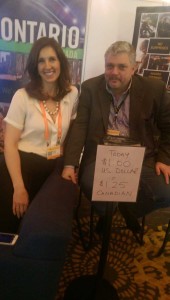![]()

But there was also an elephant in the room, a topic that drew scant discussion at the trade show, but could well turn out to be a game changer when it comes to where a production chooses to locate in the near future. And that is the dramatic surge in the value of the dollar against other currencies over the last year, and especially in recent months. Furthermore, that currency upheaval could be the trigger for another tidal wave of runaway production.
Over the last 12 months, the euro has fallen by nearly 30% against the greenback (based on yesterday’s exchange rates). And both the Australian dollar and the Canadian Looney have dropped by almost 25%. What this means is that the dollar is not just worth much more, but buys more – much more – abroad.
 For American travelers, Europe is a bargain, because it now costs only $1.05 to buy a euro, whereas it cost around $1.40 in March 2014. It’s much the same bargain for a producer that decides to make a movie in the Eurozone, in Australia, in Canada, or in the many other foreign countries that have also experienced big falls in their currencies. Shooting in Canada, which has long been a magnet for attracting U.S. films and television shows because of compelling tax breaks, now becomes overwhelmingly cheap.
For American travelers, Europe is a bargain, because it now costs only $1.05 to buy a euro, whereas it cost around $1.40 in March 2014. It’s much the same bargain for a producer that decides to make a movie in the Eurozone, in Australia, in Canada, or in the many other foreign countries that have also experienced big falls in their currencies. Shooting in Canada, which has long been a magnet for attracting U.S. films and television shows because of compelling tax breaks, now becomes overwhelmingly cheap.
The only exhibitor at the locations show to highlight the impact of the rising dollar was Toronto, which hung a scribbled sign showing that a U.S. dollar was that day worth 1.25 Canadian dollar. By yesterday it had gone up to 1.27. That’s a six-year low for the Looney and represents a 22 percent drop in 10 months. “It’s quite remarkable,” said Michelle Alosinac, the sector development officer for the Toronto Film, Television and Digital Media Office. “People follow the money. And our lower dollar plus our substantial tax credits make us very competitive.”
The arithmetic is pretty compelling for Toronto and the rest of the province of Ontario (as well as for Montreal and Vancouver, two other Canadian entertainment production centers). There’s already a 25% percent refundable tax credit for film and television production in Ontario. And that credit can go to 40% and even higher for VFX and digital work. Add in the currency differential, and the savings for making a film or television show in Toronto tops 45 percent and could go as high as 60 percent for digital work.
 Right now the incentives are under review by the provincial government which needs to come up with some major budget cuts. But even with a slice in the incentive rates, a show or film that shoots in Toronto will still cost 40% less than it would in Los Angeles. States like Georgia, Louisiana and New Mexico that feel they have put forward the most generous tax breaks to pull in productions can’t compete with that kind of mix of Canadian incentives along with currency depreciation.
Right now the incentives are under review by the provincial government which needs to come up with some major budget cuts. But even with a slice in the incentive rates, a show or film that shoots in Toronto will still cost 40% less than it would in Los Angeles. States like Georgia, Louisiana and New Mexico that feel they have put forward the most generous tax breaks to pull in productions can’t compete with that kind of mix of Canadian incentives along with currency depreciation.
Currency markets are extremely volatile, so it is hard to predict where exchange rates will be a year from now. That’s why production companies and film commissions are both gingerly evaluating the present tumult. Though some forecasters are suggesting that the dollar and the euro may soon reach 1:1 parity, the latest move in the dollar to a 12-year high could also be a market overshoot, leading to a reversal.
What’s driving the latest surge in the greenback is a growing differential in interest rates between the U.S. and Europe, based on diverging central bank policies, and also falling oil prices that further weaken the currencies of energy producers like Canada.
Studios don’t have economists on staff to parse such trends. But they have witnessed enormous dollar gyrations over the years, both up and down, that have made a big difference in where it’s cheapest to shoot. The magnitude of recent currency moves is just beginning to filter into budget calculations.

Also, France along with other countries in the Eurozone is enormously advantaged by the growing differential between the euro and the dollar. Should it persist, overall savings from a French shoot could approach 60%, making what has been thought of as one of the most expensive places in the world to film into a veritable bargain basement for U.S. production companies. “It’s a very nice extra icing on the cake,” said Priot. Producers he met with while in L.A. were very receptive to the pending jump in French filming incentives, while starting to buzz about the cheap euro. “It seemed to them almost too good to be true,” he declared.





